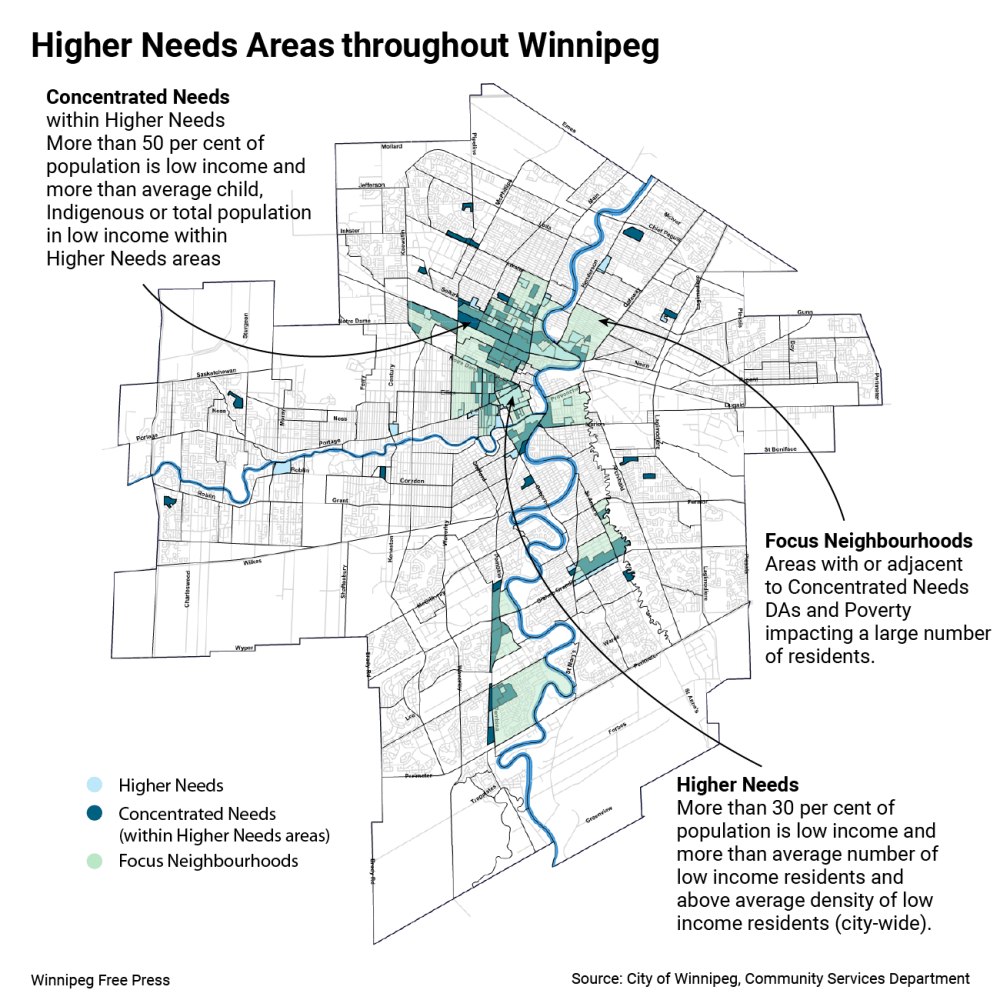New city map highlights higher-needs area
Advertisement
Read this article for free:
or
Already have an account? Log in here »
To continue reading, please subscribe:
Monthly Digital Subscription
$19 $0 for the first 4 weeks*
- Enjoy unlimited reading on winnipegfreepress.com
- Read the E-Edition, our digital replica newspaper
- Access News Break, our award-winning app
- Play interactive puzzles
*No charge for 4 weeks then billed as $19 every four weeks (new subscribers and qualified returning subscribers only). Cancel anytime.
Read unlimited articles for free today:
or
Already have an account? Log in here »
Hey there, time traveller!
This article was published 25/02/2020 (1519 days ago), so information in it may no longer be current.
A new civic map highlights where poverty is most often experienced in Winnipeg.
The areas of highest needs are based primarily on the total number of people living on low incomes.
Coun. Sherri Rollins (Fort Rouge-East Fort Garry), who chairs the protection and community services committee, noted the list includes many inner-city areas, such as the Centennial, Spence, and Point Douglas neighbourhoods, as well as some areas near the south end of the city along Pembina Highway.
The civic report does caution poverty exists to some extent throughout Winnipeg. In total, a city spokesperson said Wednesday about 94,830 Winnipeggers are now considered to live on low incomes — based on a measure that assesses the income required for a basic standard of living.
While the report itself doesn’t make specific recommendations to support the communities, Rollins said the data is valuable.
“Getting this information into the community’s hands, in terms of defining higher-needs neighbourhoods… and making sure that it’s influencing (our) actions was the purpose of the report,” she said.
The chart defines higher-needs areas as those where more than 30 per cent of the population is low income, and where both the density and number of low-income residents is greater than average.

The city also charts out concentrated needs areas, which meet higher-needs criteria plus at least one of the following: more than 50 per cent of the population is low income; a greater number of low-income residents than the average for higher-needs areas; a greater number of Indigenous low-income residents than the average for higher-needs areas; or a greater number of low-income children than the average for higher-needs areas.
Focus neighbourhoods are defined as those adjacent to concentrated-needs areas and where poverty impacts a large total number of residents.
Rollins said such data has helped guide affordable housing investments in the past, and could also help target recreation and library investments, as well as other social supports.
“It is information that can inform decision making,” she said.
The report was originally ordered as part of Winnipeg’s action plan to combat methamphetamine and illicit drug use, based on links between drug use and poverty.
However, a local anti-poverty advocate said he fears the city won’t do enough to respond to the data.
Josh Brandon, community animator for the Social Planning Council of Winnipeg, said he’s concerned potential service cuts could make life for those in poverty worse.
Brandon called potential pool, library and arena closures in the lead-up to next week’s city budget “risky,” as such services can be used by those living in poverty to avoid crime.
“We really need to concentrate on those areas. We need to make sure that young people have access to services, that families have access to health care, that there’s adequate recreational opportunities… so that poverty doesn’t weigh on them so deeply,” said Brandon.
He said the city has taken some encouraging steps, such as plans to add a low-income bus pass, but it should make further investments in housing, recreation and community outreach — even if that requires steeper property tax hikes.
“It may be time for Mayor (Brian) Bowman to look at lifting the 2.33 per cent cap on property taxes that he’s had for the last several years, and direct some of that towards these really important anti-poverty programs,” Brandon said.
joyanne.pursaga@freepress.mb.ca

Joyanne Pursaga
Reporter
Born and raised in Winnipeg, Joyanne loves to tell the stories of this city, especially when politics is involved. Joyanne became the city hall reporter for the Winnipeg Free Press in early 2020.



